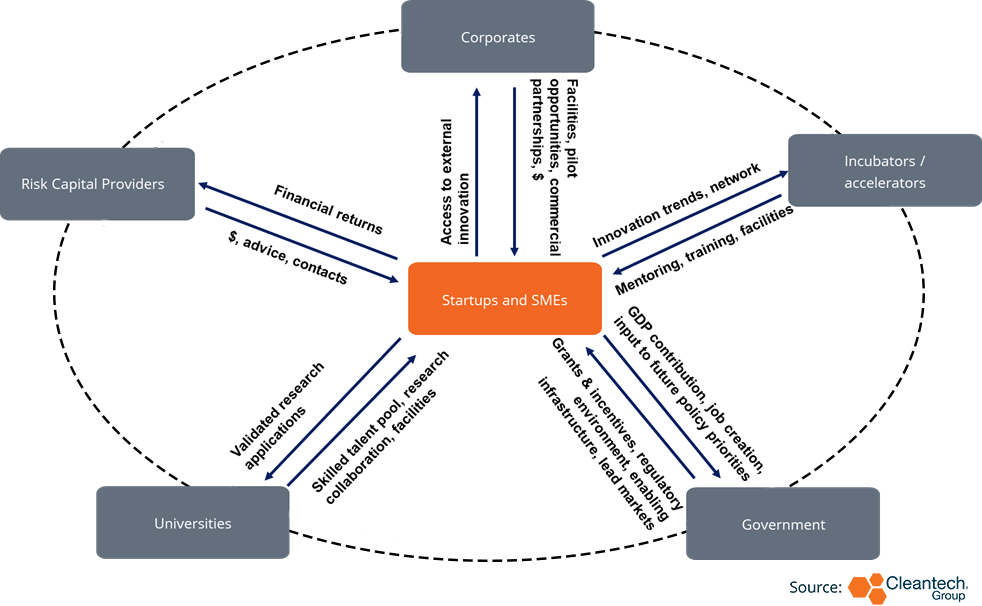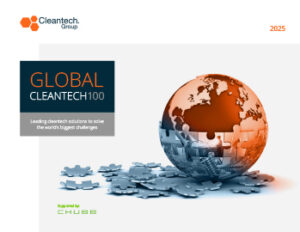A Framework for Evaluating Cleantech Innovation Ecosystems
The Global Cleantech 100 is coming in January, and we’ve spent the last few months evaluating some of the world’s most exciting cleantech startups. There are some truly inspiring innovations out there. We can’t give out any spoilers for the 2023 list, but highlights from last year include smart thermostat developer Tado, cultured meat producer Mosa Meat and sustainable concrete producer Solidia – along with 97 others. Going way back, an early Global Cleantech 100 included an EV company you may have heard of called Tesla.
Last year’s list was dominated by North America and Europe, and we are keen to see companies from other parts of the world make future lists. As countries around the world seek to strengthen their own cleantech innovation ecosystems to nurture the Tesla’s of tomorrow, we developed a framework to identify the key actors in a cleantech ecosystem, and to understand how they interact with each other to create value and allow the ecosystem to grow.
Hardware Companies Have Specific Needs (We Will Not Solve the Climate Crisis with Software Alone)
The innovators above have one thing in common. They are all developing physical products or processes – and while software companies also make important contributions to resource efficiency, ultimately hardware innovations will be necessary to decarbonise or substitute the most polluting processes of today’s world. These companies have key differences from pure software plays, which translate into specific needs as they scale.
- Cleantech Companies Take Longer to Commercialize: Hardware innovators must first develop and demonstrate the technology before going on to commercialize. This can add years to the path to market.
- Cleantech Companies are Often Based on Scientific Research: Many cleantech innovations are born in university or research labs, and founded by researchers, who may need business training to become startup founders.
- Cleantech Companies Have Specific Talent Requirements: Successful founding teams need a mix of technical skills and the advanced commercial skills required to articulate the benefits of new, complex products to potential customers.
Effective Cleantech Innovation Ecosystems are Organized Around the Specific Needs of Cleantech Companies
MIT has identified five key stakeholders in general innovation ecosystems: entrepreneurs, governments, universities and other research organizations, risk capital providers and corporations. Each of these stakeholders makes specific contributions to the ecosystem, fulfilling responsibilities to the other groups. We talk about these in more detail below.
Our analysis shows that in cleantech innovation ecosystems, a sixth stakeholder group – accelerators – is also significant, for a variety of reasons. First, cleantech founders often come from a scientific and/or research background and may have little previous experience in formulating a business plan or articulating a commercial value proposition. Second, early-stage hardware startups carry a significant amount of technology risk, and early-stage risk capital providers need ways of evaluating and mitigating that risk. Accelerators play a vital role in helping early-stage cleantech startups overcome these hurdles.
Location is important. Our research shows that startup activity in a region is correlated with the presence of research organizations, venture funding and accelerators. These are particularly important at the early stages, where a company needs to successfully articulate its value proposition in order to attract first funding. Later-stage funding may come from further afield, but many companies find their first private funder close to home.
Individual failures contribute to the overall ecosystem. Sometimes, startups don’t make it (there’s a reason it’s called risk capital). But they often leave behind knowledge, suppliers, and people who move on to the next adventure. Therefore, investment in early-stage ventures is often an investment in the whole ecosystem. Of course, quality is also important, and by prioritizing the allocation of limited resources, every ecosystem actor works to ensure support for the highest quality startups with the highest potential to scale. Many funders now evaluate climate impact projections as well as financial ones.
Roles and Responsibilities in Cleantech Innovation Ecosystems

- Startups are the main focus of any cleantech ecosystem. High growth startups bring innovative solutions to climate-related problems and are able to scale those solutions rapidly for climate impact. Effective ecosystems create the conditions for cleantech startups to thrive and enabling these young companies to scale up as quickly as possible should be the overarching goal.
Cleantech startups also contribute to sustainable GDP growth and quality, future-proof job creation. Former founders often ‘give back’ to the ecosystem by mentoring other founders and backing new ventures.
- Universities and Research Organisations often underpin regional clusters of cleantech innovation, by producing quality IP and talent. High-performing universities often contribute to commercializing the IP produced, through spinout facilities and sometimes by providing early funding to nascent ventures.
- Risk Capital Providers include business angels, philanthropic investors, VCs and growth investors. As well as providing capital to ventures which are too risky for conventional capital providers, these funders also provide valuable network access and contacts which help startups to establish themselves more quickly. They may also provide more hands-on sector or function-specific support.
- Corporations may develop cleantech solutions in-house. They are also vital as customers of cleantech solutions. By partnering with innovative startups to co-develop pilot projects, the most progressive corporates also play an important role in bringing TRLs (Technology Readiness Levels) forward by demonstrating solutions in real-world environments.
- Government can employ a variety of measures which create the macro conditions for cleantech startups to grow. These include a range of interventions:
- Defining research priorities
- Providing targeted support and incentives to back research, innovation and early-stage commercial projects
- De-risking scaling ventures to ‘crowd in’ private financing
- Coordinating value chains to ensure availability of critical inputs, whether these are materials or other supply chain actors.
Government is also responsible for defining and implementing targets, regulations and standards, ensuring sufficient infrastructure development, and creating early markets for cleantech products and services, for example through green public procurement.
- Accelerators and Hubs may be operated by any of the other ecosystem actors or may be stand-alone entities. They support early-stage startups with mentoring, skills development, access to networks, facilities and sometime financing. Because entry to a program is usually competitive, accelerators with a good track record also serve as a guarantee of quality to early-stage investors.
All in all, it takes a village to create great startups. Understanding how all of the various participants interact with each other to create value and allow the ecosystem to grow is key.
In partnership with UNIDO’s Global Cleantech Innovation Programme (GCIP), Cleantech Group has developed an ecosystem evaluation framework. Find it here in the Cleantech Innovation Capacity Building Framework.



